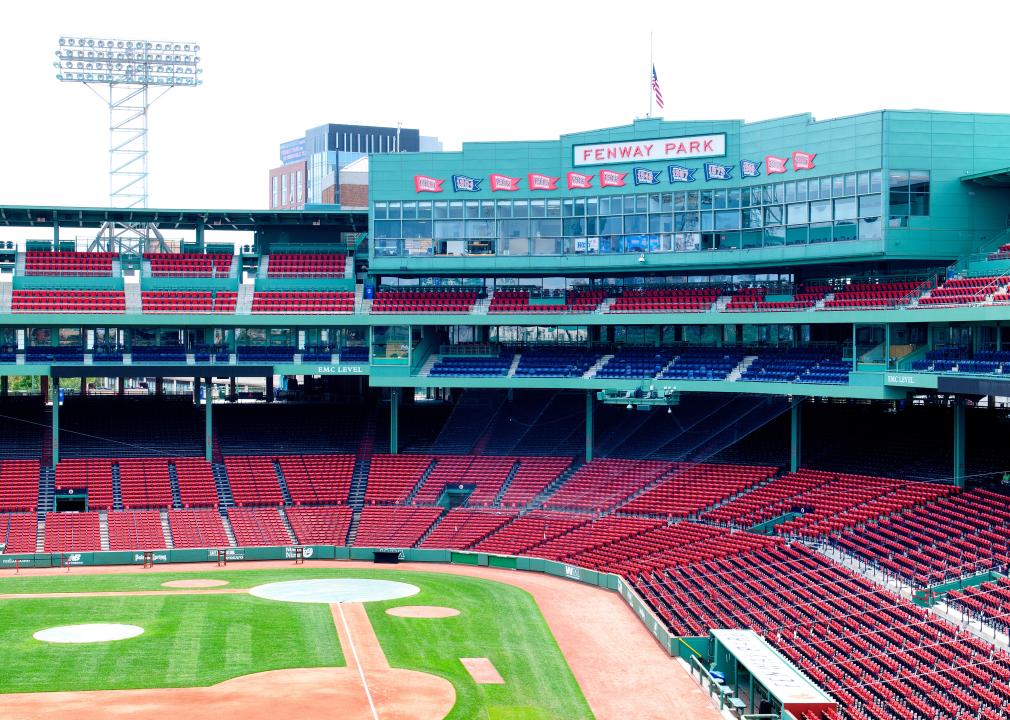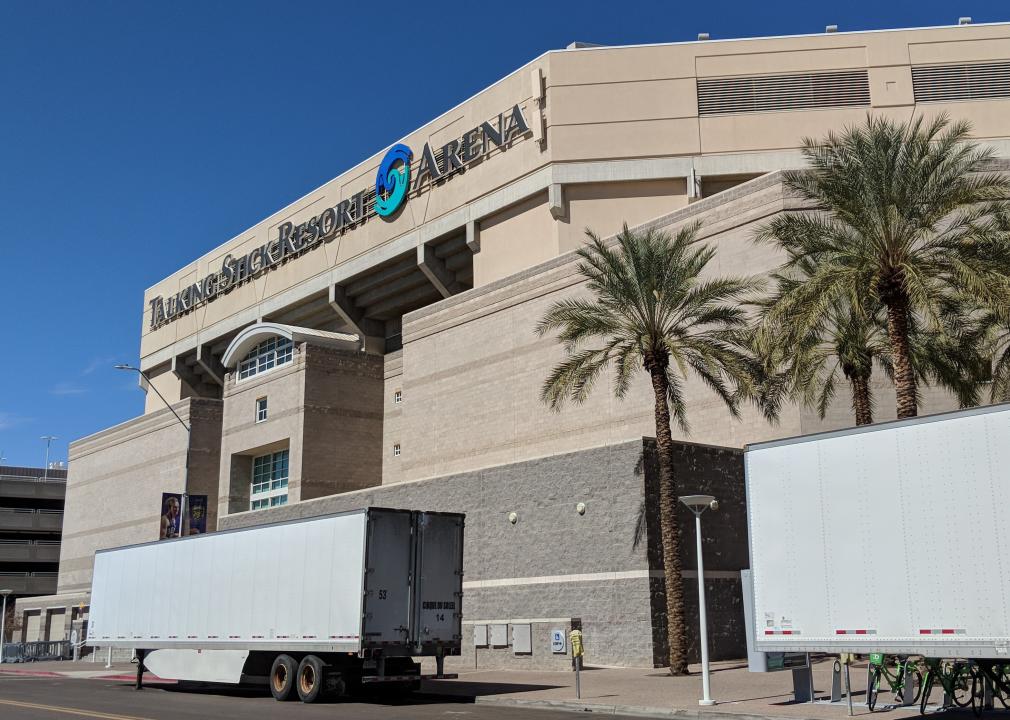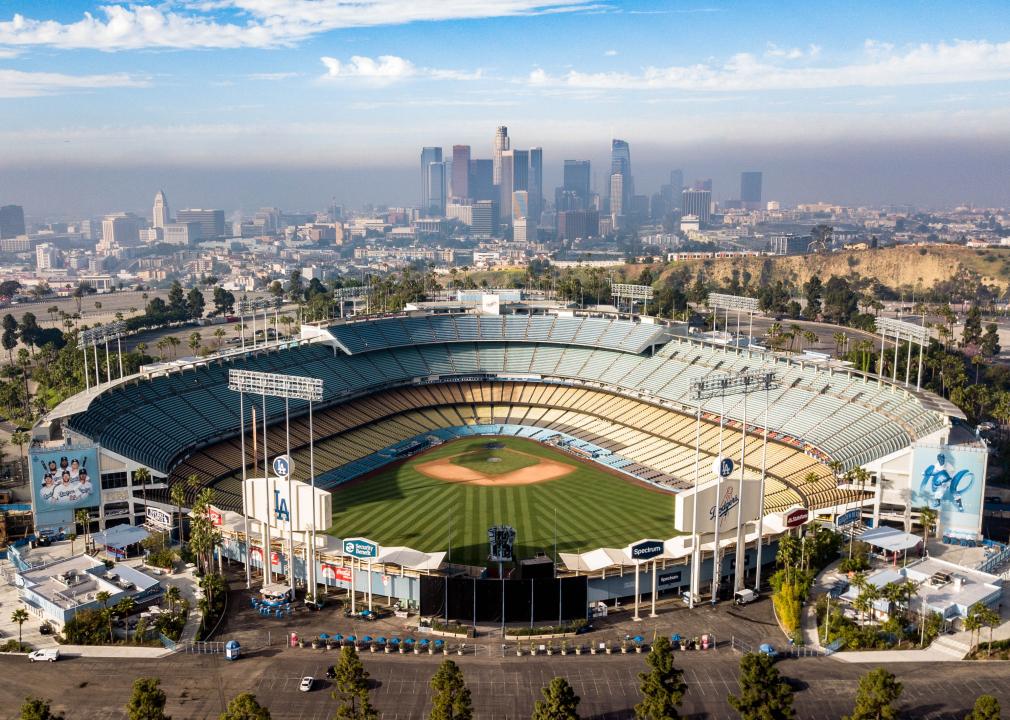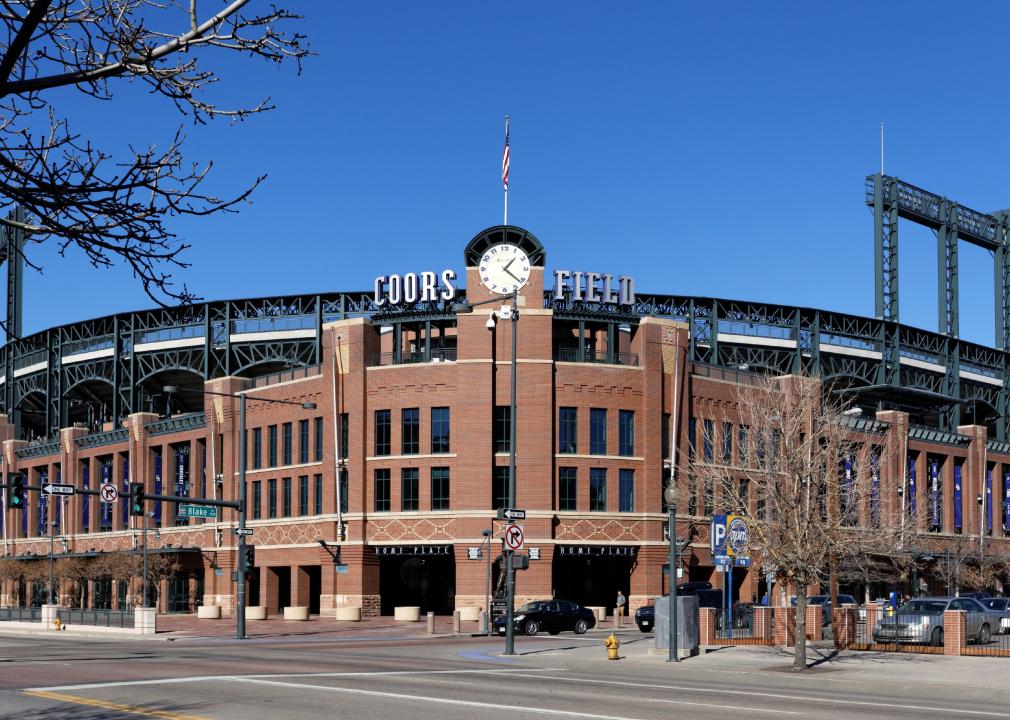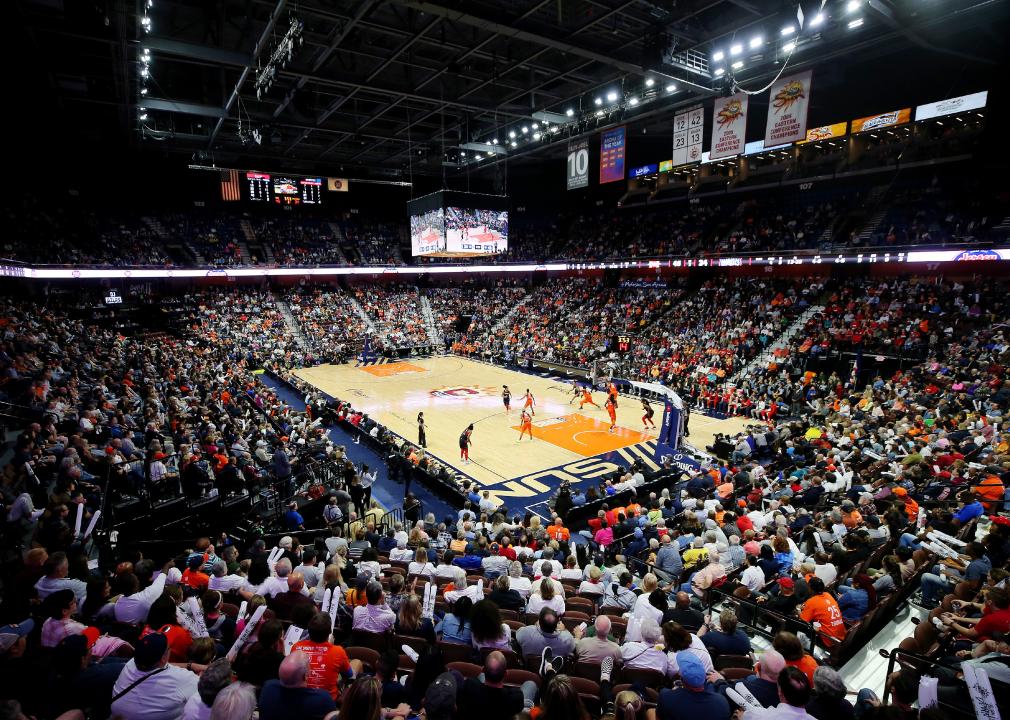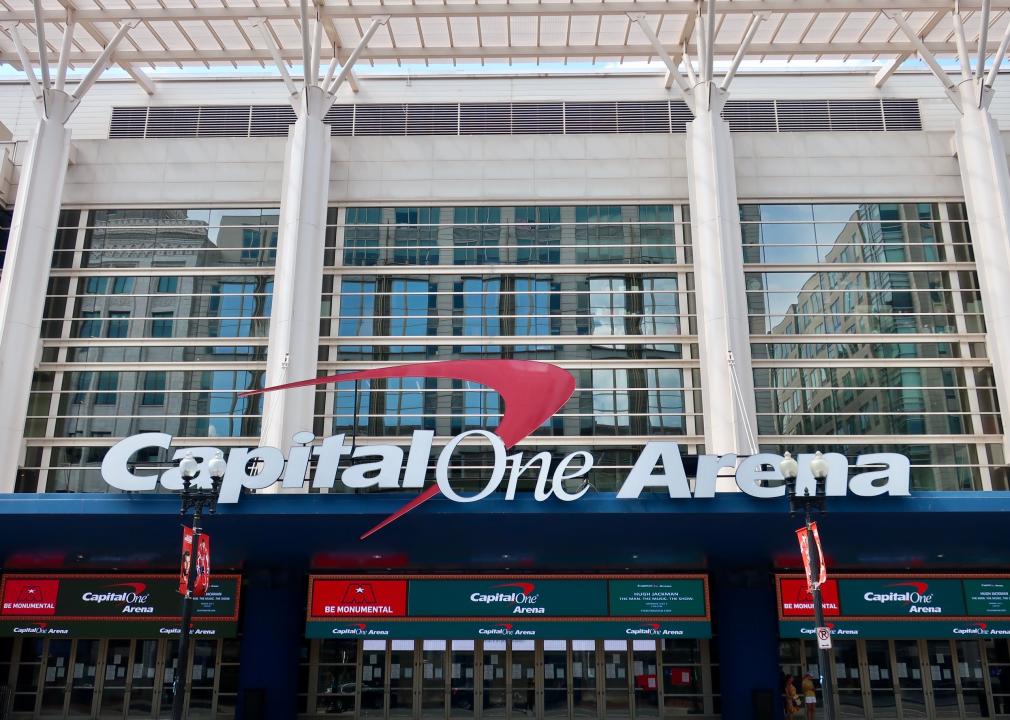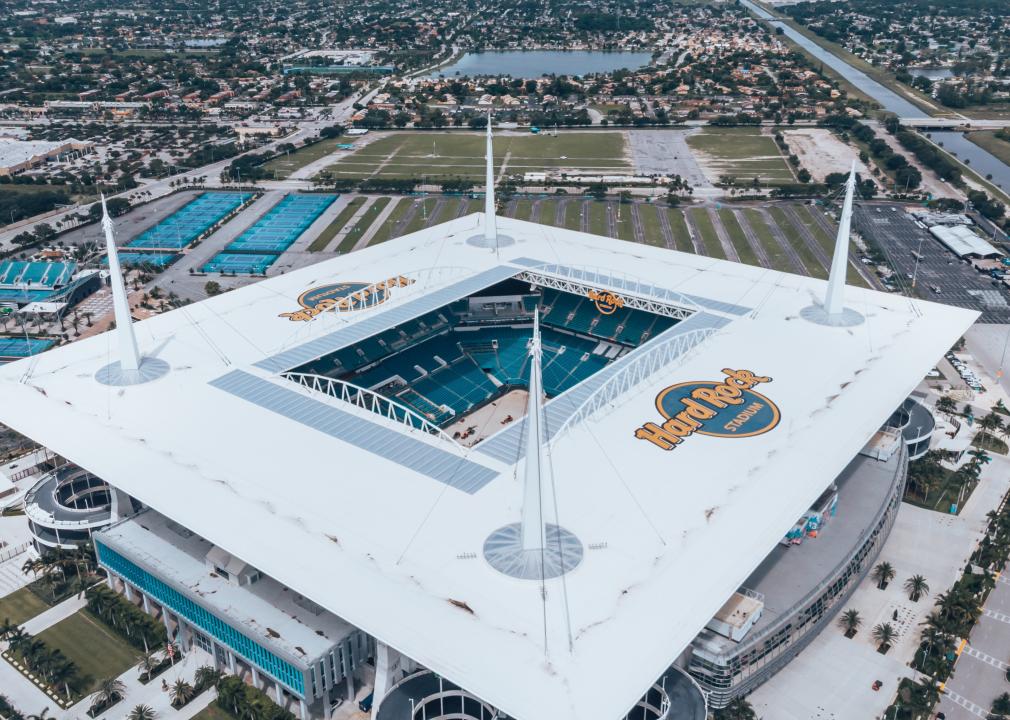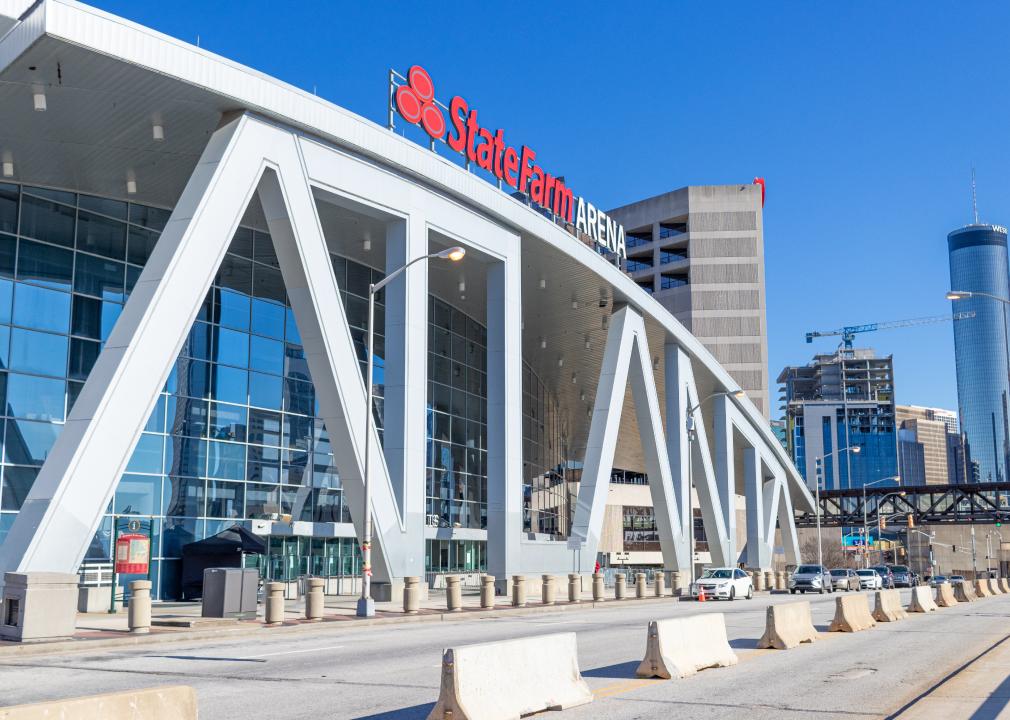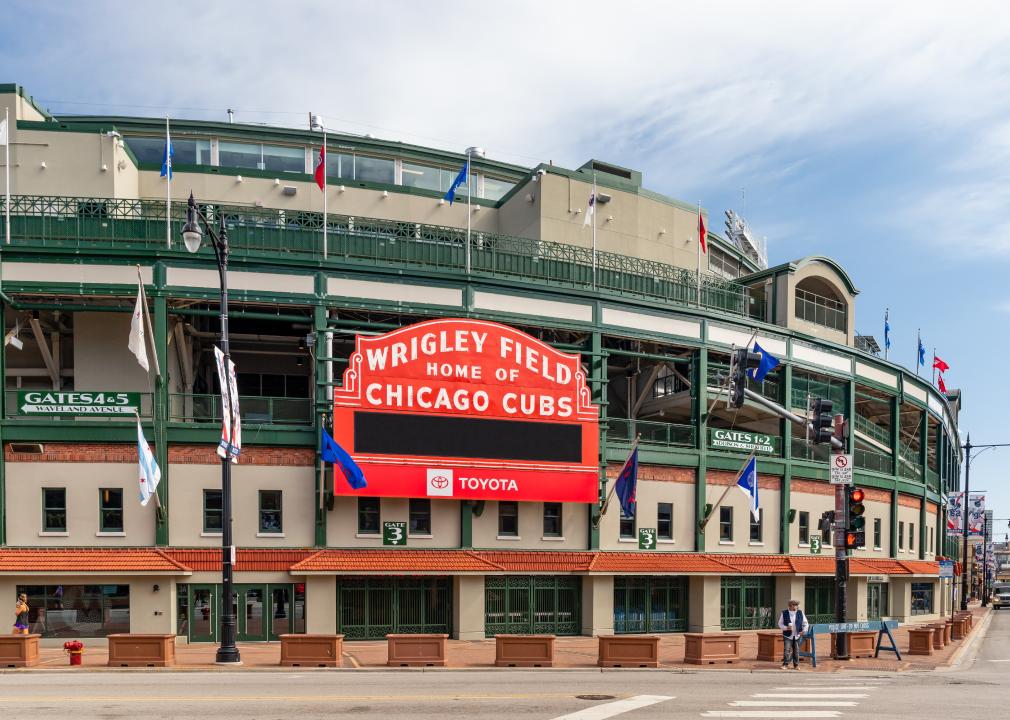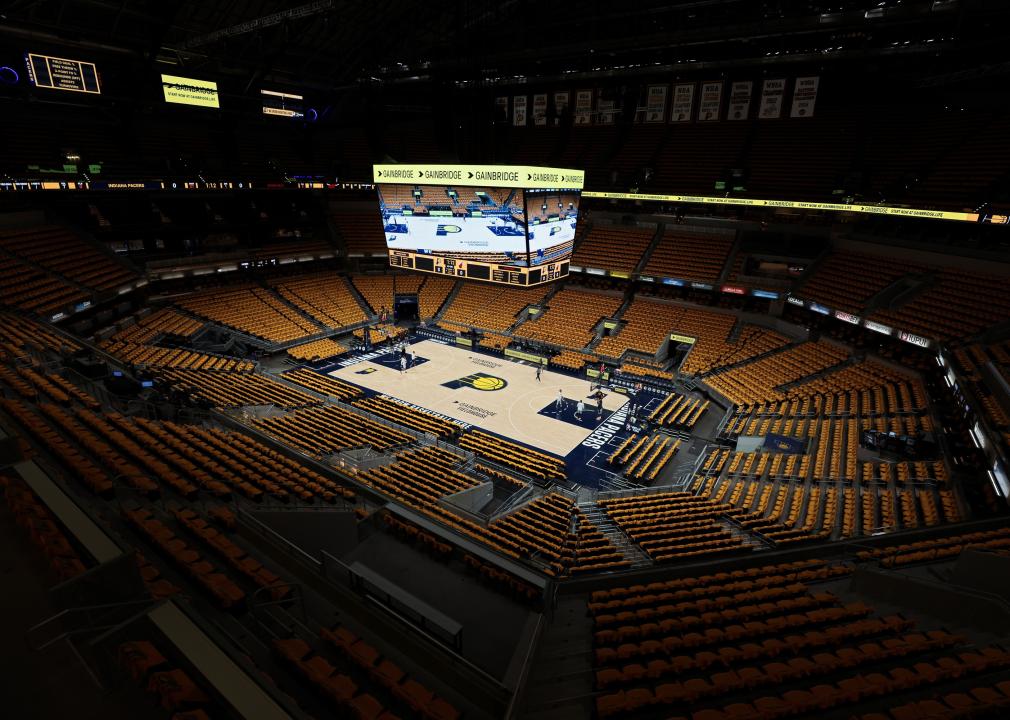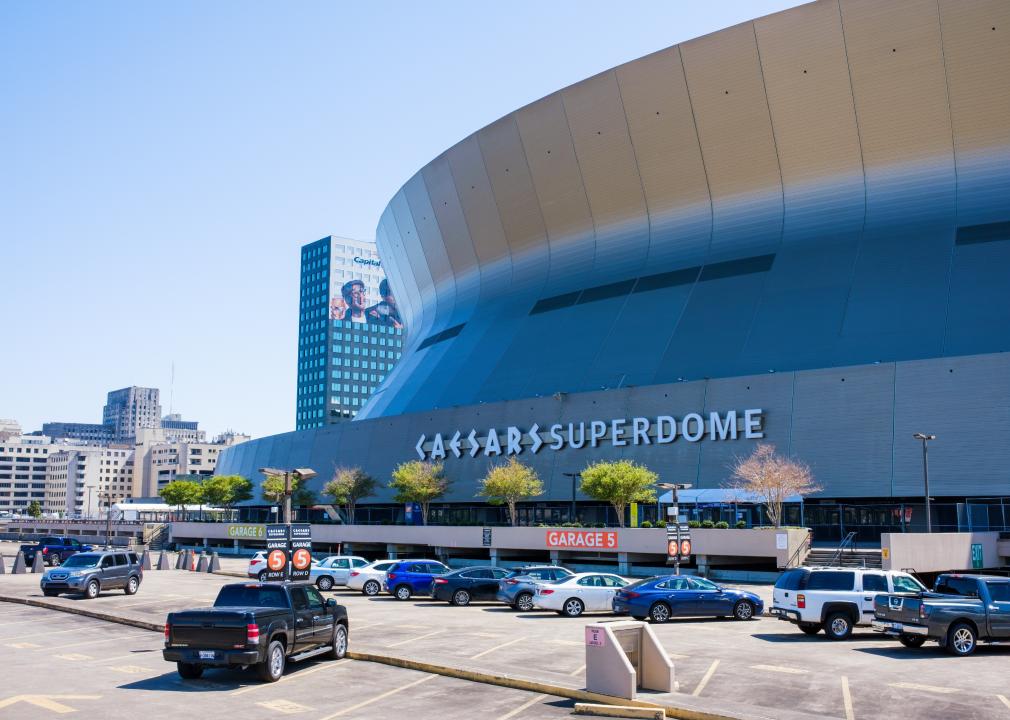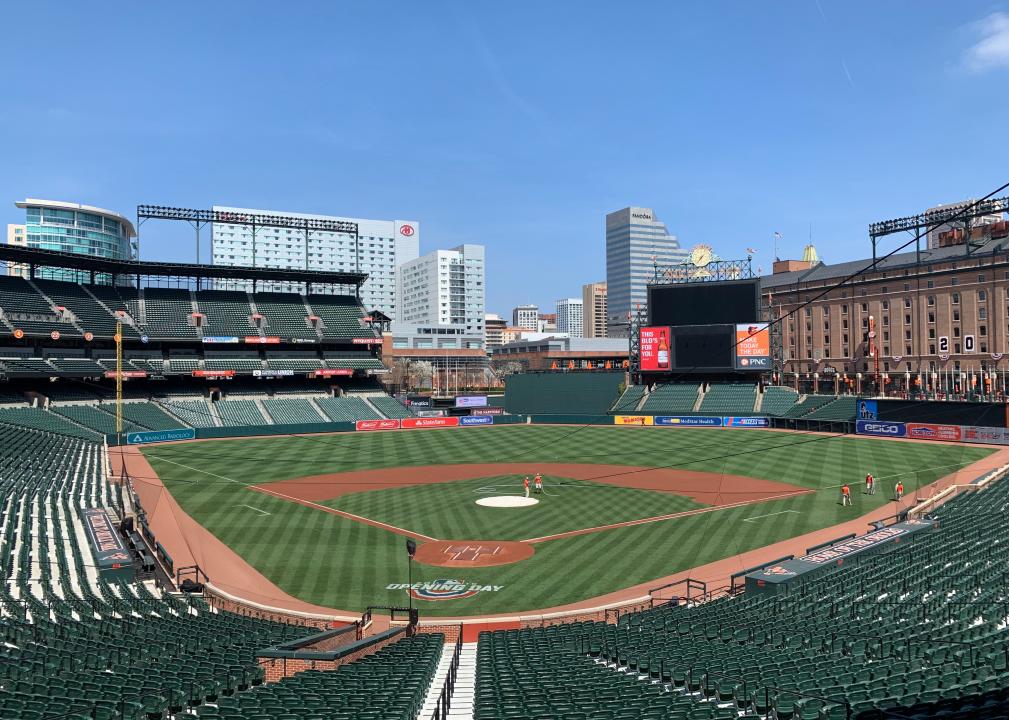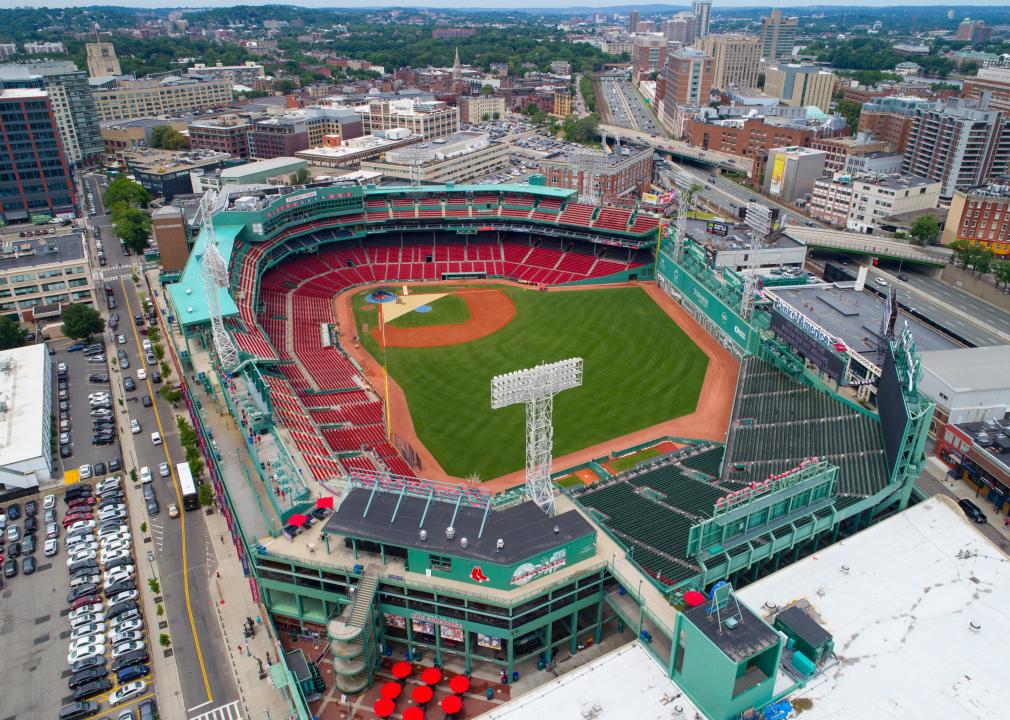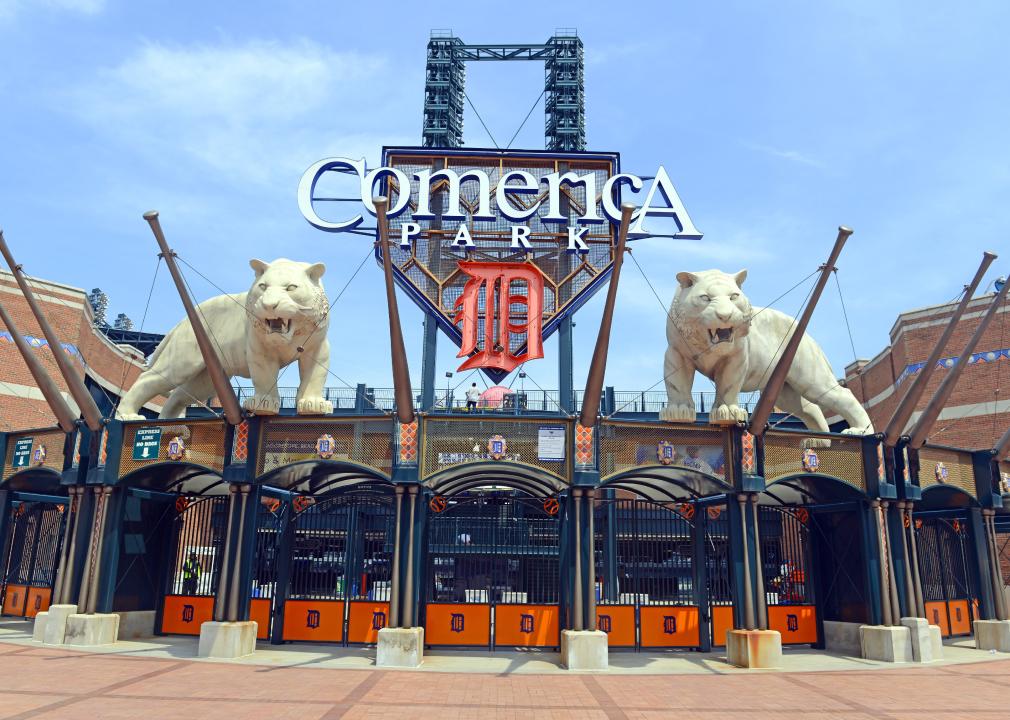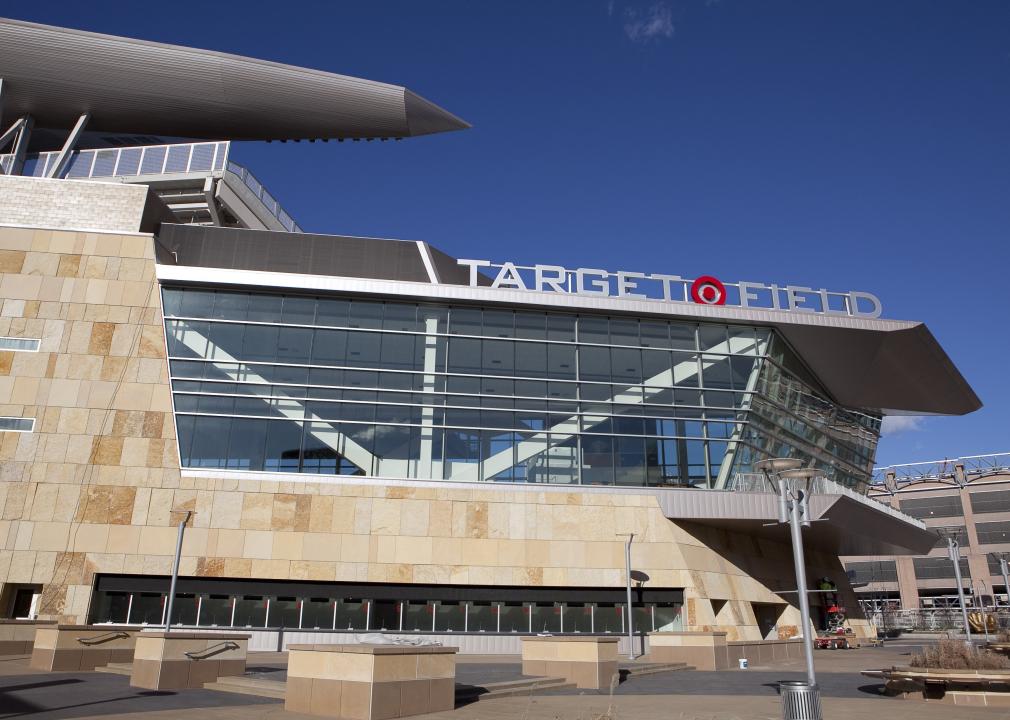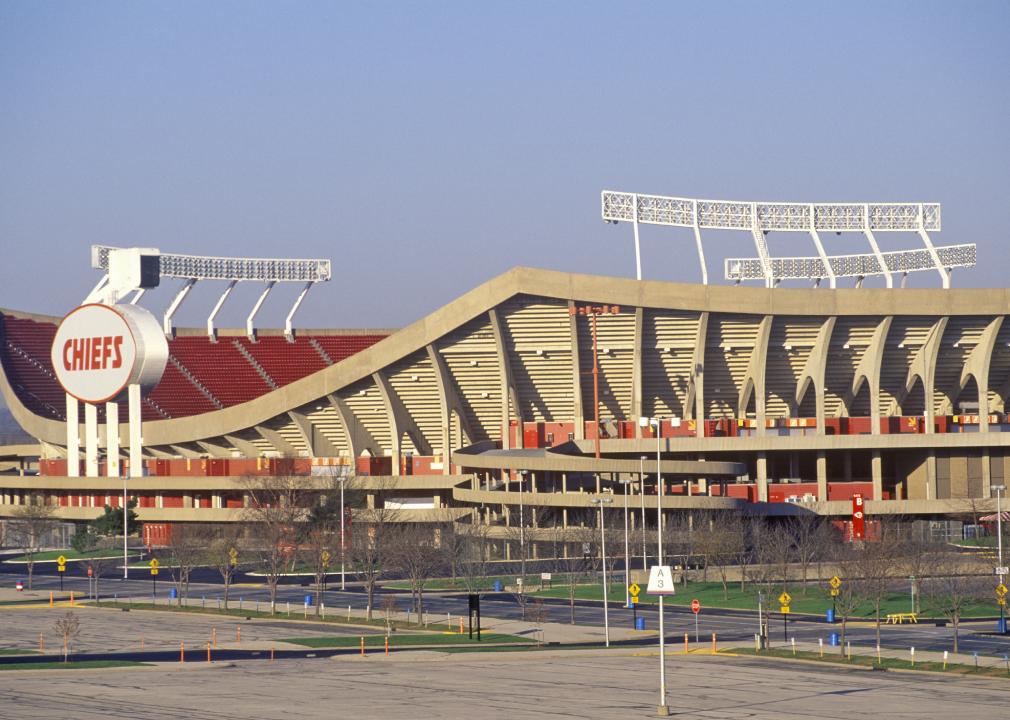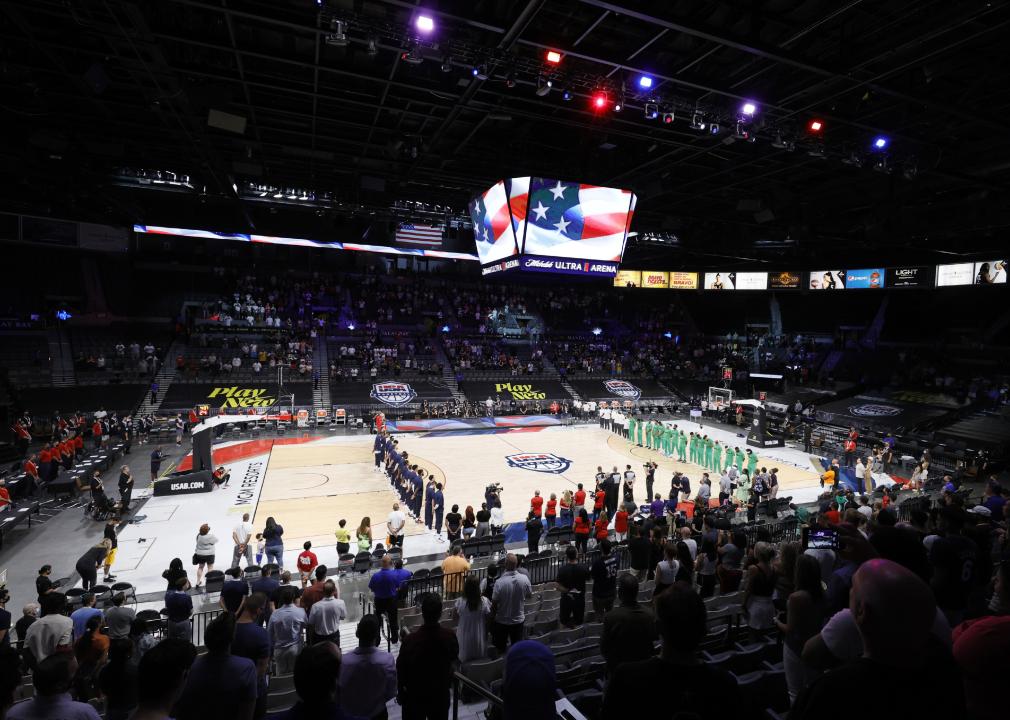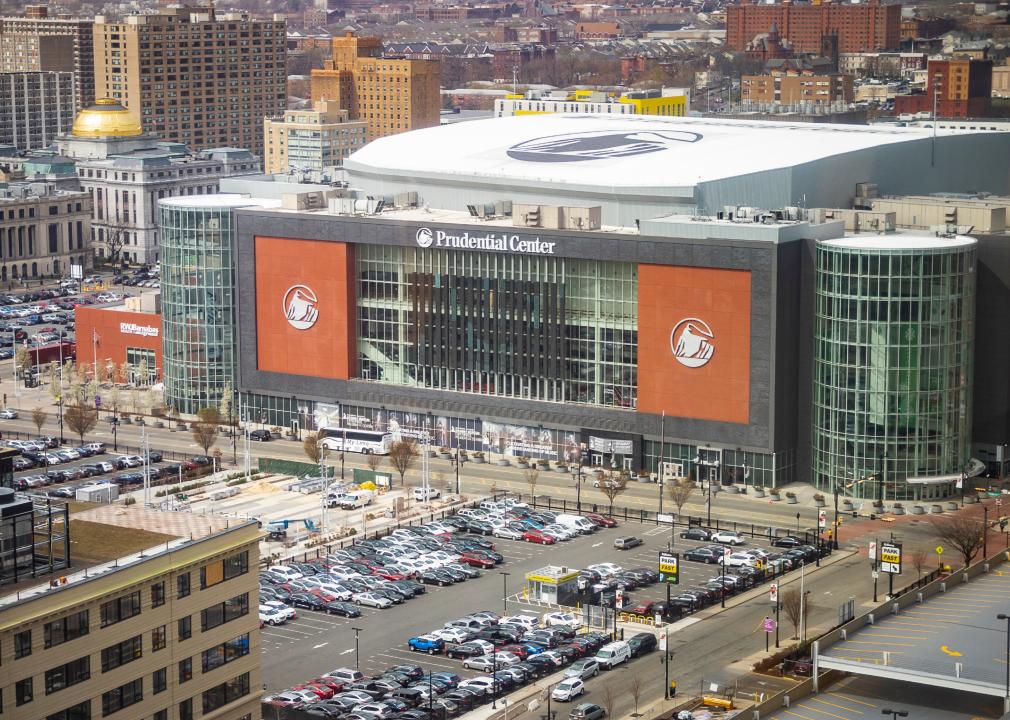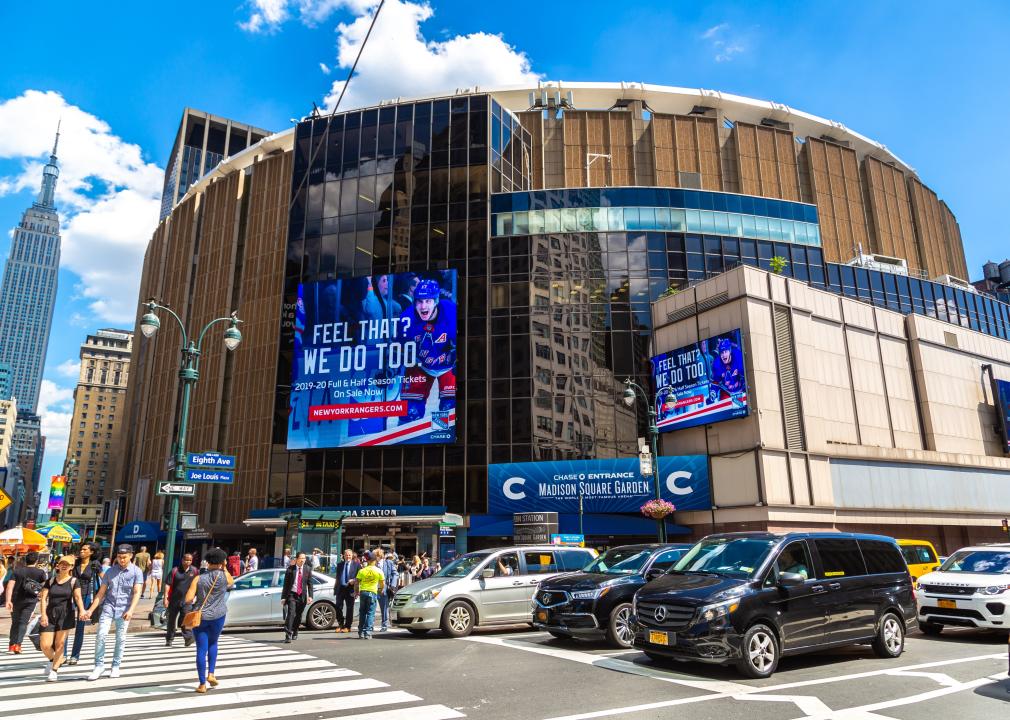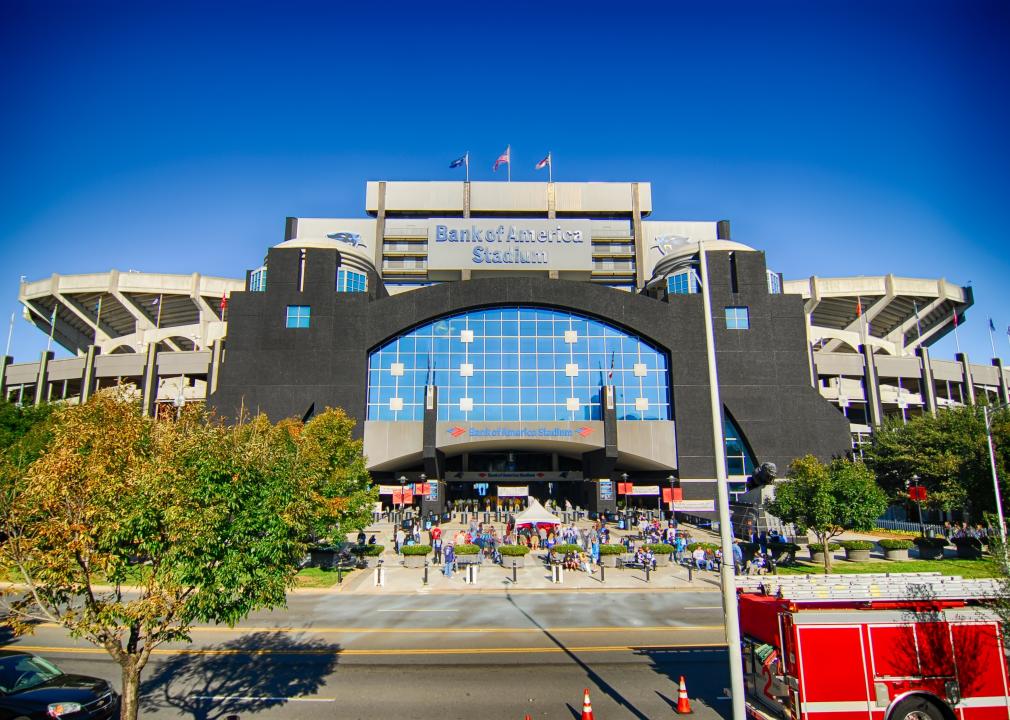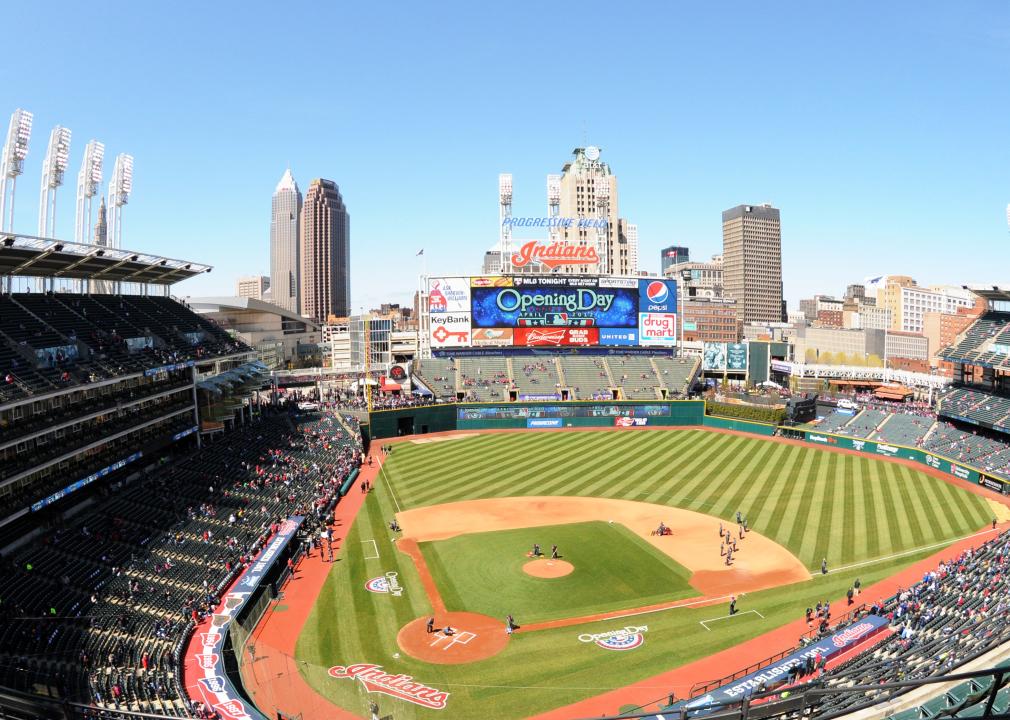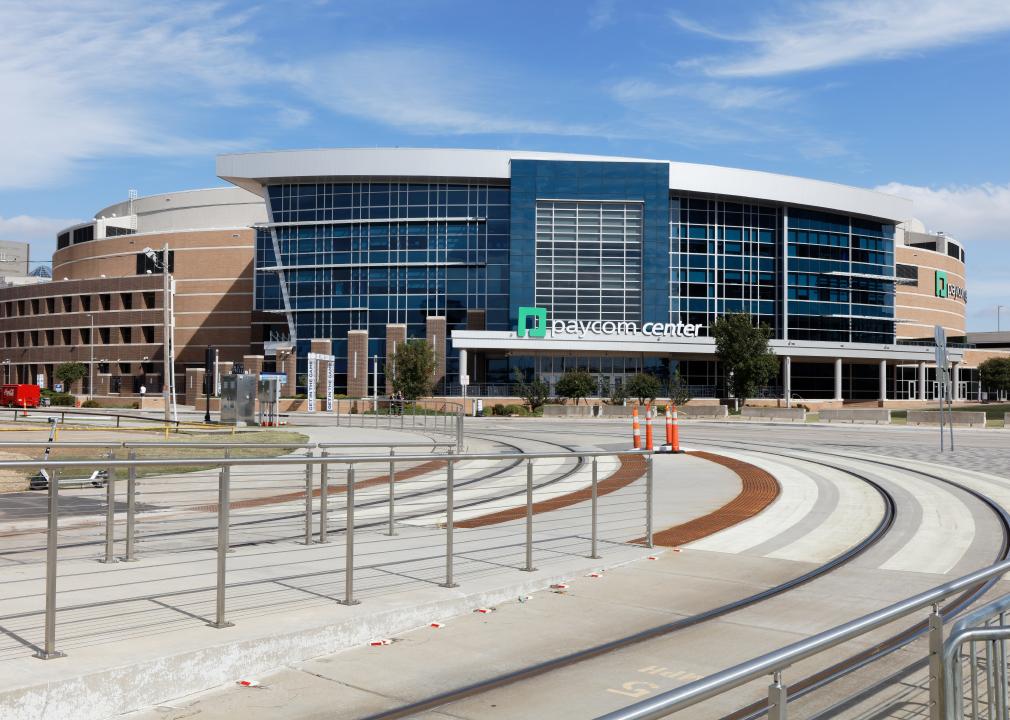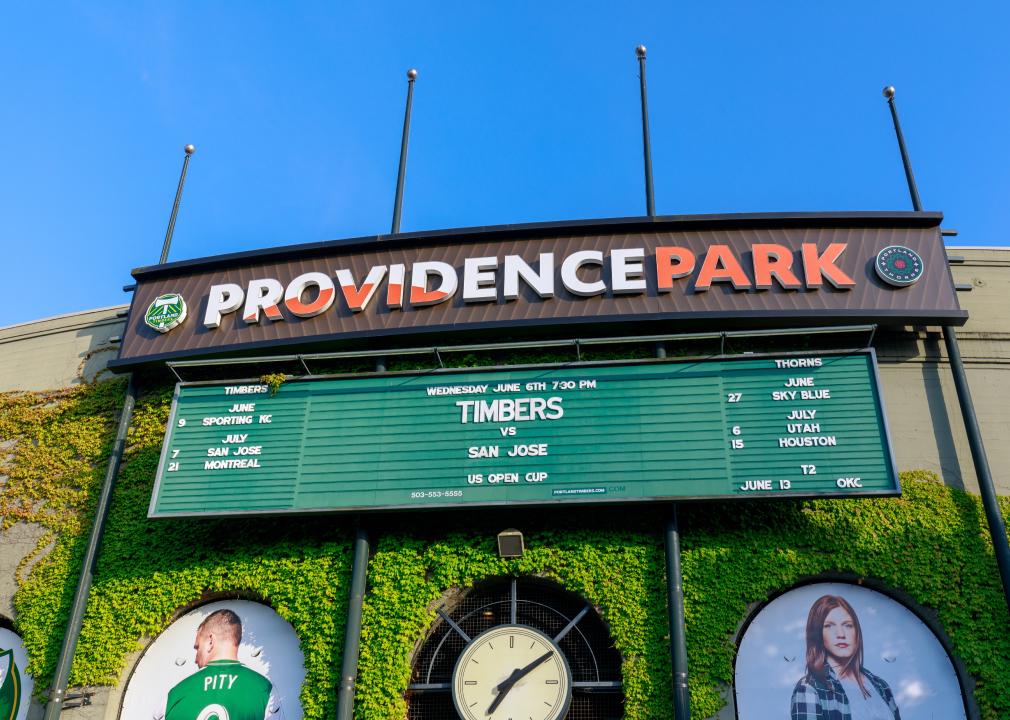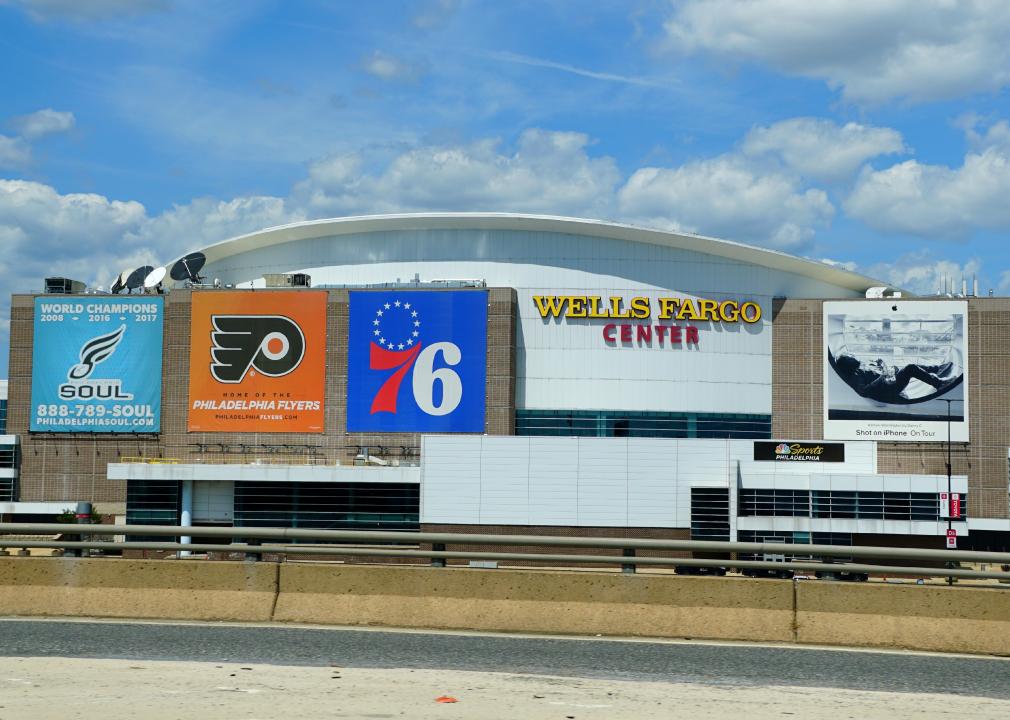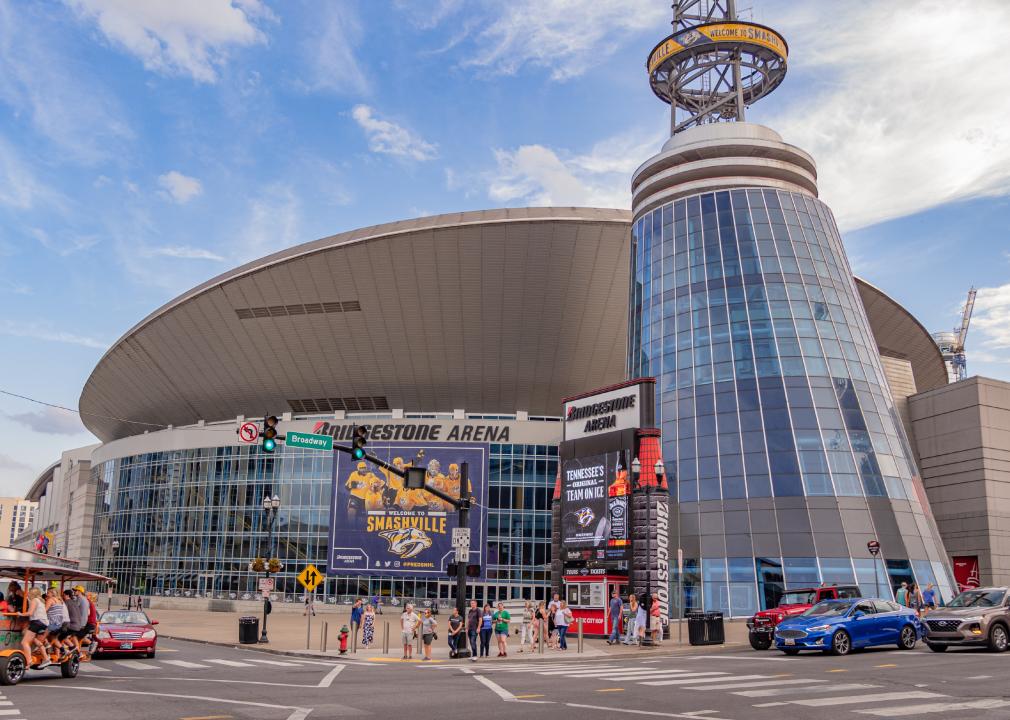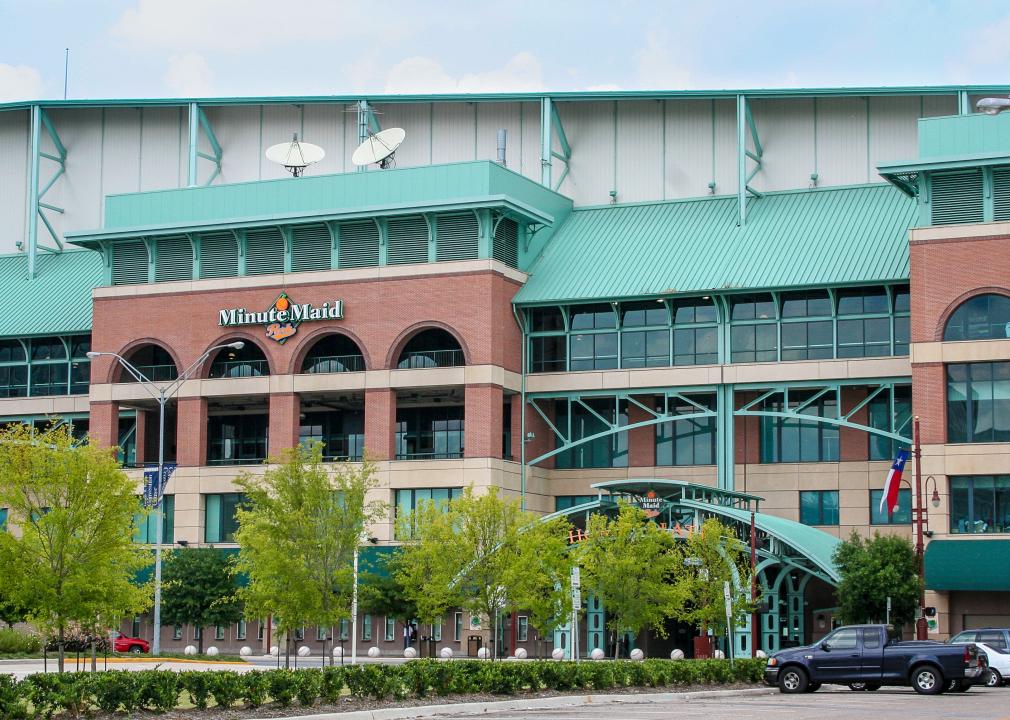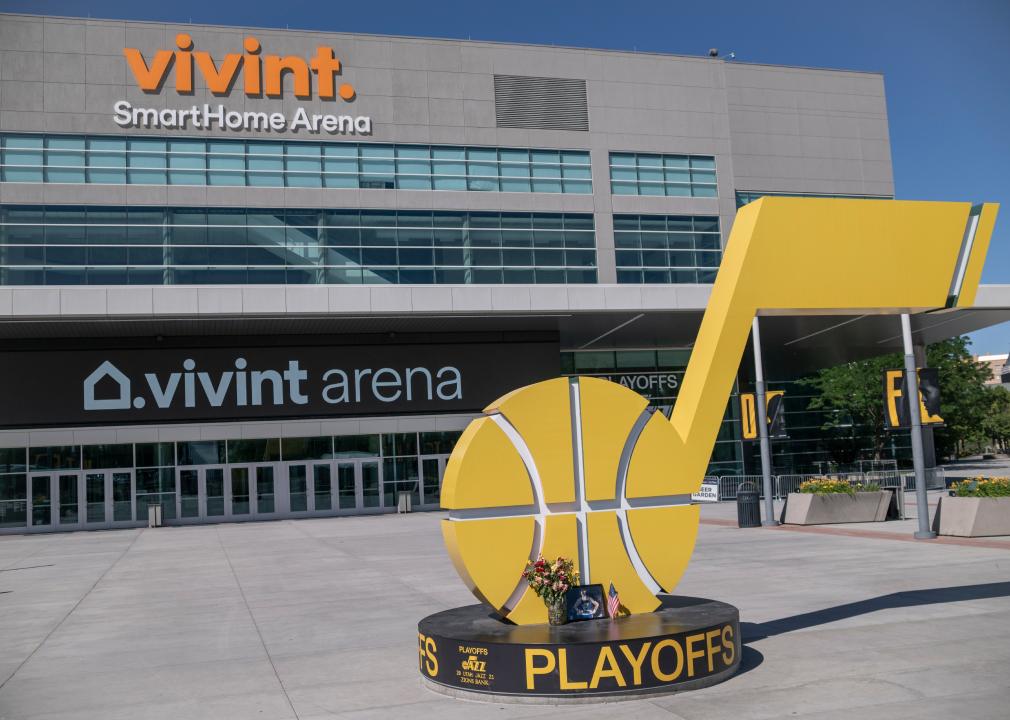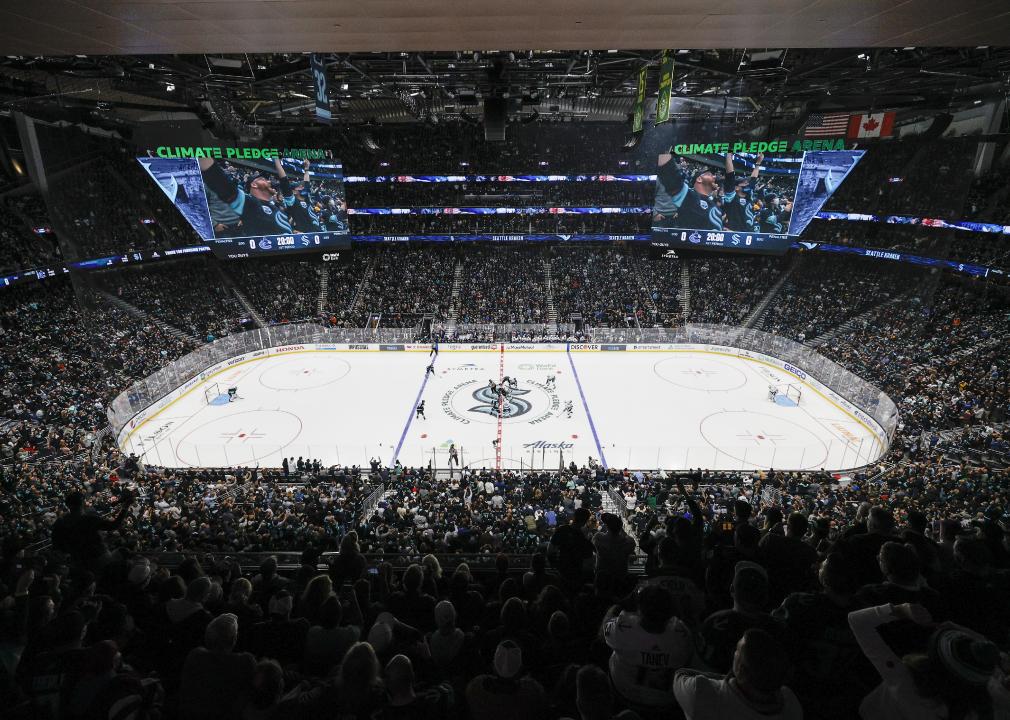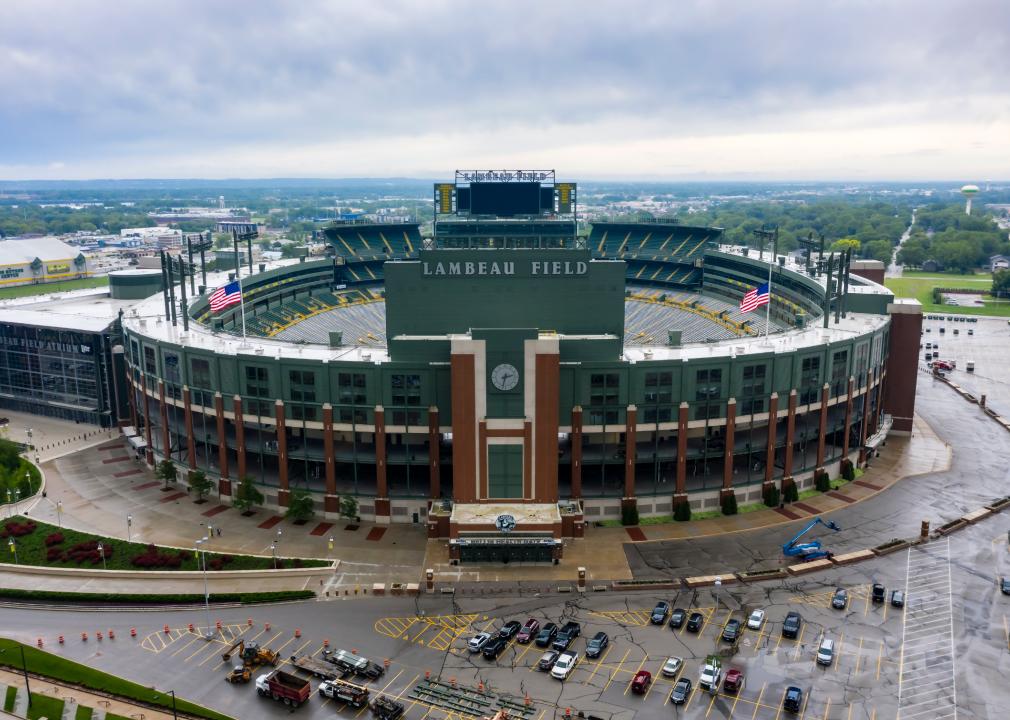From Fenway to Lambeau: The oldest sports venue in each state with major league teams
ladyphoto89 // Shutterstock
From Fenway to Lambeau: The oldest sports venue in each state with major league teams
View of Empty Fenway Park
Some wines and beautiful people get better with age, while others fade over the years. The same is true of sports venues. Some stadiums and arenas deteriorate and become forlorn after only a couple of decades, while others are still vital and beloved a century after they were built—helped along by occasional renovations. Cubs and Knicks fans are as fond of Wrigley Field and Madison Square Garden, respectively, as they are of their teams.
Vivid Seats determined the oldest major sports venue in every state with at least one top professional league team using data from stadium, arena, league, and news websites. Major sports were defined as all teams in the NFL, MLB, NBA, WNBA, NHL, MLS, and NWSL—pro leagues with teams that play in a total of 145 venues. The average age of these venues is 22.4 years, and only 20 opened in 1990 or earlier.
NBA arenas appear most often on this list, with nine of the 28 venues hosting men’s basketball teams. The MLB comes in second with eight; the NHL and WNBA venues have six each; the NFL has five; the NWSL has four; and MLS stadiums appear three times.
Venues were chosen based on the original opening date. Renovations were not factored in, except in cases where the original structure was demolished.
![]()
You Touch Pix of EuToch // Shutterstock
Arizona: Footprint Center
Arena with parked nearby trailers
– Year opened: 1992
– City: Phoenix
– Capacity: 18,055
– Teams: Phoenix Suns (NBA), Phoenix Mercury (WNBA)
Major renovations completed in 2003 and 2021 have brightened the Suns’ arena since its opening three decades ago. Arizona’s oldest sports arena has also played host for legendary concerts—an elderly Frank Sinatra performed one of his last shows there—and recently announced a partnership with Footprint in 2021. In addition to gaining naming rights, Footprint, which produces plastic alternative materials, will help the venue become a carbon-neutral, plastic-free arena.
Emma_Griffiths // Shutterstock
California: Dodger Stadium
Dodger Stadium with downtown LA in the background
– Year opened: 1962
– City: Los Angeles
– Capacity: 56,000
– Team: Los Angeles Dodgers (MLB)
Perched at the top of Chavez Ravine, Dodger Stadium has welcomed more than 147 million baseball fans since opening day. The 2.8 million people who filled the seats in the West Coast’s oldest baseball stadium in 2021 was the most for any MLB stadium by more than a half-million. Today, the stadium remains one the third oldest continually used parks in major league history.
Katherine Welles // Shutterstock
Colorado: Coors Field
Coors Field in Denver, Colorado
– Year opened: 1995
– City: Denver
– Capacity: 50,398
– Team: Colorado Rockies (MLB)
Pitchers have hated it and sluggers have loved it for nearly three decades. But the stadium known for tape-measure home runs in the thin air of Denver keeps on chugging. (That’s a beer reference to Coors Field.) The rooftop party deck that debuted in 2014 is one of the features that has helped to maintain the venue’s popularity.
Maddie Meyer // Getty Images
Connecticut: Mohegan Sun Arena
A general view of Mohegan Sun Arena during WNBA Finals
– Year opened: 1999
– City: Uncasville
– Capacity: 9,323
– Team: Connecticut Sun (WNBA)
Many “firsts” can be attributed to this arena, including the first professional sports arena owned by a Native American tribe (the Mohegan), the first sports arena attached to a casino, and the first arena to host a WNBA team that’s unaffiliated with an NBA team.
Taylor Swift and Kenny Chesney have performed there, but the main attraction is the Sun, a team piggybacking on the longtime popularity of UConn women’s basketball. The team has made it to three WNBA Finals and had the best record at 26-6 among all WNBA teams in 2021.
DCStockPhotography // Shutterstock
District of Columbia: Capital One Arena
Capital One Arena sign at entrance to stadium
– Year opened: 1997
– City: Washington
– Capacity: 20,600 (basketball), 18,506 (hockey)
– Teams: Washington Wizards (NBA), Washington Capitals (NHL)
Home to the Capitals, winners of the 2018 Stanley Cup, and the Wizards, who are still chasing a conference title, the arena sits in D.C.’s Penn Quarter neighborhood. Fans fill its 20,000 seats for an average of 220 events a year, ranging from the Harlem Globetrotters and NCAA men’s basketball to horse shows and ice skating championships.
YES Market Media // Shutterstock
Florida: Hard Rock Stadium
Aerial view of Hard Rock Stadium
– Year opened: 1987
– City: Miami Gardens
– Capacity: 65,326
– Team: Miami Dolphins (NFL)
It’s changed names an average of once every four-plus years, and this stadium has hosted many events: six Super Bowls, four BCS National Championships, two World Series (when it doubled as the Marlins’ stadium), all University of Miami Hurricanes home games, the annual Orange Bowl, and—as the new name suggests—many rock concerts. That’s a lot of wear and tear after 35 years. But it’s held up reasonably well as the first U.S. multipurpose stadium financed entirely by private investors.
Erik Gonzalez // Shutterstock
Georgia: State Farm Arena
View of the State Farm Arena in the city of Atlanta
– Year opened: 1999
– City: Atlanta
– Capacity: 16,600
– Team: Atlanta Hawks (NBA)
The NHL’s Thrashers moved to Winnipeg and the WNBA’s Atlanta Dream to a newer metro Atlanta stadium, but the Hawks haven’t yet flown off to another arena. Extensive renovations in 2017-18 to the downtown arena—the first LEED-certified NBA/NHL arena built—brought it up to date. The Hawks have done their part to keep fans flocking to games by heading to the playoffs for two straight years.
Hendrickson Photography // Shutterstock
Illinois: Wrigley Field
The exterior of Wrigley Field stadium
– Year opened: 1914
– City: Chicago
– Capacity: 41,649
– Team: Chicago Cubs (MLB)
Chew on this: Wrigley opened three months before World War I broke out, in 1914. It’s survived through two world wars, two global pandemics, and multiple renovations—not to mention a 108-year drought in the championship fortunes of the Cubs. Because Cubs fans have always loved its “jewel box” design and ivy-covered walls, they kept showing up until the “Cubbies” finally claimed a World Series title in 2016—one year later than the 1989 time-traveling sequel “Back to the Future Part II” had foretold.
Dylan Buell // Getty Images
Indiana: Gainbridge Fieldhouse
A general view at Gainbridge Fieldhouse
– Year opened: 1999
– City: Indianapolis
– Capacity: 17,923
– Teams: Indiana Pacers (NBA), Indiana Fever (WNBA)
A $360 million renovation of this arena—part of an arrangement that will keep the Pacers in Indy for at least another 25 years—is scheduled for completion in fall 2022. Changes include a reworking of the upper concourse that will allow fans in those seats to get a view of both the court and the city skyline. Created specifically to watch basketball, the venue’s original design was inspired by Indiana’s traditional fieldhouse gymnasiums.
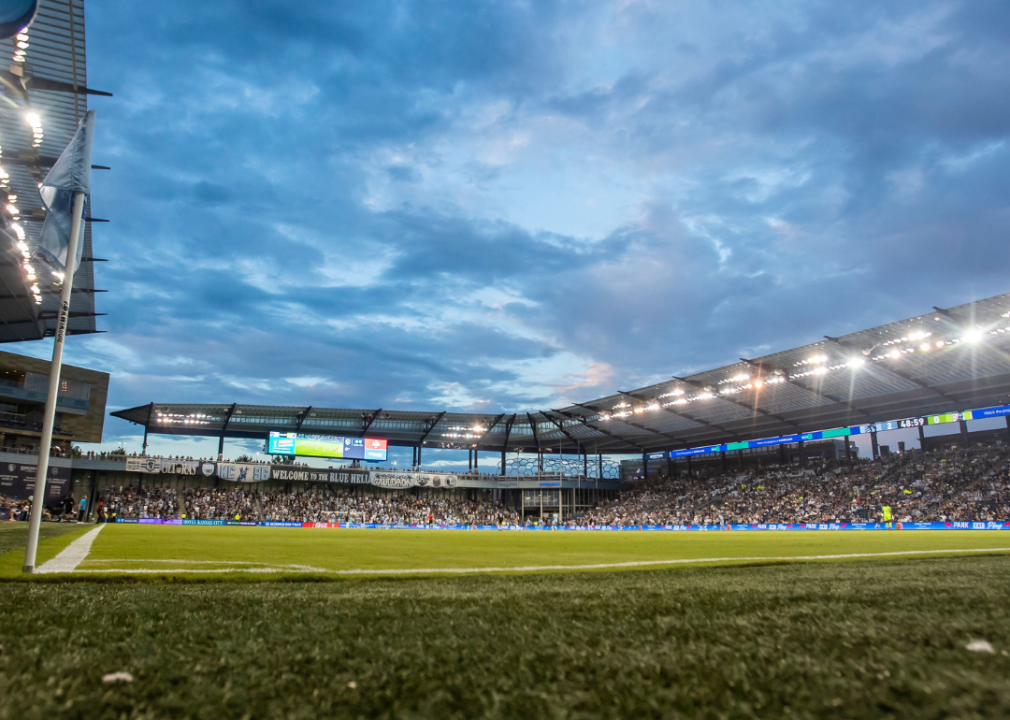
Nick Tre. Smith/Icon Sportswire via Getty Images
Kansas: Children’s Mercy Park
Interior of Children’s Mercy Park in Kansas City
– Year opened: 2011
– City: Kansas City
– Capacity: 18,467
– Team: Sporting Kansas City (MLS), Kansas City Current (NWSL)
Located on the Kansas side of the Kansas City metropolitan area, Children’s Mercy Park is the only major league sports stadium in the state. It’s notably the first—and currently only—stadium to host the MLS Cup, MLS All-Star Game, and a U.S. Men’s National Team game in a calendar year, having done so in 2013.
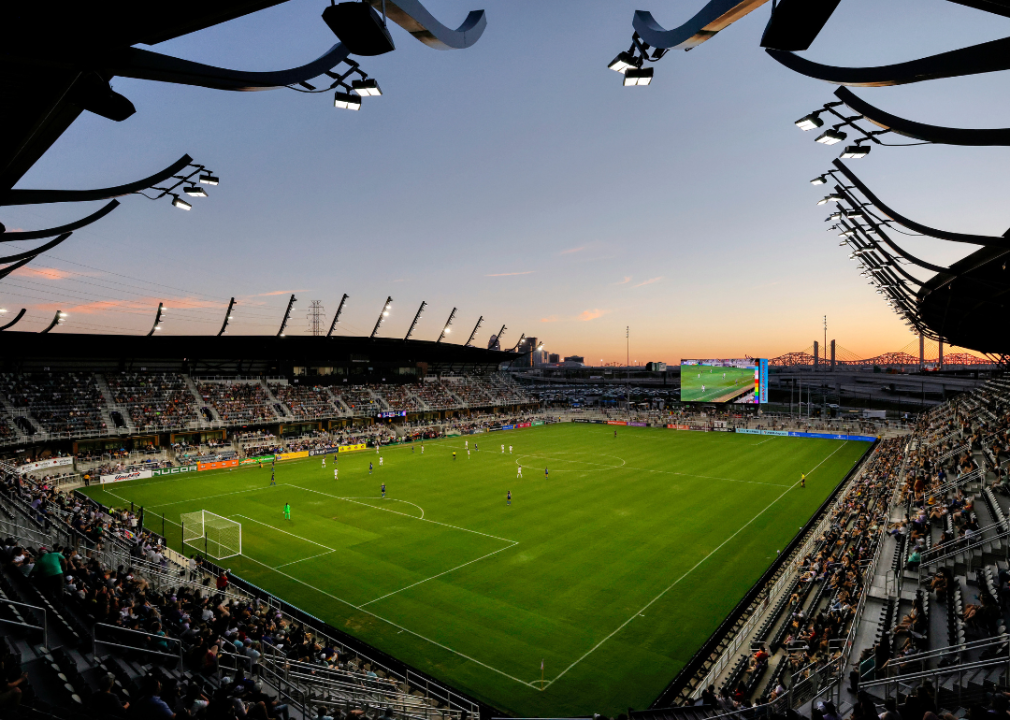
Joe Robbins/ISI Photos // Getty Images
Kentucky: Lynn Family Stadium
Interior of Lynn Family Stadium in Louisville, Kentucky
– Year opened: 2020
– City: Louisville
– Capacity: 15, 304
– Team: Racing Louisville FC (NWSL)
Initially built for USL Championship side Louisville City, Lynn Family Stadium has been home to the NWSL’s Racing Louisville since 2021. The stadium’s naming rights were purchased for an undisclosed sum by Cindy and Dr. Mark Lynn, a Louisville-based optometrist with ownership stakes in multiple Visionworks locations.
William A. Morgan // Shutterstock
Louisiana: Caesars Superdome
Superdome with parking lot and hint of the skyline
– Year opened: 1975
– City: New Orleans
– Capacity: 73,000
– Team: New Orleans Saints (NFL)
This aging stadium has hosted an impressive seven Super Bowls, but drew the most global news coverage in 2005, when it hosted thousands of flood refugees in the wake of Hurricane Katrina. The storm damaged the stadium, but it was repaired in time for the Saints to resume playing in it the following season. Its next Super Bowl was in 2013—a point of pride for Louisianans, but not without technical difficulty due to a 34-minute partial power-outage delay during the third quarter. The Superdome will host the Super Bowl again in 2025.
Amy Roswurm // Shutterstock
Maryland: Camden Yards
Orioles Park at Camden Yards
– Year opened: 1992
– City: Baltimore
– Capacity: 45,971
– Team: Baltimore Orioles (MLB)
This was the first “retro” stadium to be built—part of a movement to replace baseball/football dual-use stadiums with cozier, baseball-only venues that offered the friendlier ambiance of throwbacks like Fenway and Wrigley.
To say it was an instant “hit” is an understatement—more like a home run, as the average game attendance jumped by more than 10,000. Attendance has slumped in recent years; however, Orioles fans may be ready to flock back if top prospect Adley Rutschman can change the team’s fortunes.
Felix Mizioznikov // Shutterstock
Massachusetts: Fenway Park
Aerial image of Fenway Park sports stadium
– Year opened: 1912
– City: Boston
– Capacity: 37,493
– Team: Boston Red Sox (MLB)
Fenway may be a century or two newer than other Boston attractions like the Old North Church and the USS Constitution. But to baseball fans, watching left fielders chase down balls that bounce off the 37-foot-high “Green Monster” outfield wall at America’s oldest stadium is right up there with strolling through Boston Public Garden, or dining on clam chowder and cannoli. Just don’t wear a Yankees cap.
nyker // Shutterstock
Michigan: Comerica Park
Comerica Park with tiger statues
– Year opened: 2000
– City: Detroit
– Capacity: 41,083
– Team: Detroit Tigers (MLB)
Sports teams in Detroit have been slumping for decades, but you can’t blame Comerica, which does its best to draw crowds with an entertainment complex of features. Baseball fans might love ‘em or hate ‘em, but the stadium includes a carousel, a ferris wheel, a dancing water fountain near center field that can be choreographed to music, and towering tiger statues placed around the complex.
Wayne Kryduba // Getty Images
Minnesota: Target Center
An exterior general view of Target Field’s Metropolitan Club
– Year opened: 1990
– City: Minneapolis
– Capacity: 19,356
– Teams: Minnesota Timberwolves (NBA), Minnesota Lynx (WNBA)
The sports venue is the NBA’s second-oldest arena, trailing only New York’s Madison Square Garden in age. Sticking to its hometown roots, Target—which opened its first stores in the Twin Cities in the 1960s—is the original naming partner of the sports center, home to the Timberwolves and Lynx, not to mention rusty-patched bees. That last one isn’t a sports team, but the busy native residents that live on the arena’s green rooftop, a 113,000-square-foot “prairie in the sky” populated with grass, regional plants, and bee hives.
Joseph Sohm // Shutterstock
Missouri: GEHA Field at Arrowhead Stadium
Exterior view of Arrowhead Stadium
– Year opened: 1972
– City: Kansas City
– Capacity: 72,936
– Team: Kansas City Chiefs (NFL)
The first sports complex to feature side-by-side NFL and MLB stadiums, Arrowhead was built as a response to a new requirement that all NFL stadiums accommodate at least 50,000 fans. The architects did far better, creating a behemoth with a seating capacity that remains—50 years later—one of the largest in the league. The Chiefs need all those seats, too, as the Patrick Mahomes era has demanded a big venue for a team with annual Super Bowl aspirations.
Ethan Miller // Getty Images
Nevada: Michelob Ultra Arena
Players stand on the court before a game at Michelob ULTRA Arena
– Year opened: 1999
– City: Paradise
– Capacity: 12,000
– Team: Las Vegas Aces (WNBA)
Oakland Raiders owner Mark Davis built a new stadium for the team before moving them from their Bay Area enclave to the desert. Since he purchased the Aces in 2021, there’s been speculation that he’ll next build a new arena near the Strip for the Aces. Even in their old arena in an adjacent suburb, the Aces ranked second among WNBA teams for average attendance in 2021.
Benjamin Clapp // Shutterstock
New Jersey: Prudential Center
View of Prudential Center arena in downtown Newark
– Year opened: 2007
– City: Newark
– Capacity: 16,514
– Team: New Jersey Devils (NHL)
The Garden State venue is known affectionately by locals as “The Rock”—a nod to the Rock of Gibraltar featured on Prudential Financial’s logo. At just 15 years old, it still ranks as the state’s oldest sports venue, and hosted the first home game for the Devils in Oct. 2007. The hockey team won three Stanley Cups between 1995 and 2003 while playing in their old arena in East Rutherford but are still fighting for a Cup since moving to Newark.
S-F // Shutterstock
New York: Madison Square Garden
Madison Square Garden in New York City
– Year opened: 1968
– City: New York City
– Capacity: 19,763 (basketball), 18,006 (hockey)
– Teams: New York Knicks (NBA), New York Rangers (NHL)
“The Garden” has been around since 1879, but only existed in its current location since 1968, when the newest version was built to accommodate basketball and hockey games. The home for the Knicks and Rangers was a good fit, as the Knicks soon knocked out their two NBA Championships in 1970 and 1973. It took until 1994 for the Rangers to earn their first Stanley Cup in 54 years.
digidreamgrafix // Shutterstock
North Carolina: Bank of America Stadium
Exterior view of Bank of America Stadium
– Year opened: 1996
– City: Charlotte
– Capacity: 75,525
– Teams: Carolina Panthers (NFL), Charlotte FC (MLS)
Still one of only eight NFL stadiums with a capacity north of 75,000, this downtown stadium has sold out nearly every Panthers game since opening. The newer “football” team to call it home—Charlotte FC—showed that it can draw a crowd, too. In the new team’s home debut on March 5, 2022, a Major League Soccer-record 74,479 fans packed the stadium.
Diamond Images // Getty Images
Ohio: Progressive Field
A general view of Progressive Field
– Year opened: 1994
– City: Cleveland
– Capacity: 35,041
– Team: Cleveland Guardians (MLB)
Progressive Field fielded a baseball team with a not-so-progressive name (the Indians) but the name change to the Art Deco statuary-inspired Guardians fixed that. The intimate stadium holds the record as the second-smallest-capacity MLB ballpark, and the venue touts wider aisles that offer more leg room and angled seating sections that have better views of the field.
Katherine Welles // Shutterstock
Oklahoma: Paycom Center
Paycom Center in downtown Oklahoma City
– Year opened: 2002
– City: Oklahoma City
– Capacity: 18,203
– Team: Oklahoma City Thunder (NBA)
Oklahoma’s oldest major sports venue is also its newest—because it’s the only major league game in town. Owned by the city, the venue has been home to the Thunder since 2008. The team has faced a tough few seasons, ranking it third-to-last in attendance in 2021-22. The venue is a community cornerstone, hosting sporting and entertainment events from the three surrounding Oklahoma universities, as well as local high schools.
ARTYOORAN // Shutterstock
Oregon: Providence Park
Providence Park in Portland
– Year opened: 1926
– City: Portland
– Capacity: 25,218
– Team: Portland Timbers (MLS), Portland Thorns (NWSL)
Providence Park has thrived as a sports venue for nearly a century now, and soccer-mad Oregonians have made it one of America’s most popular stadiums for showcasing the sport. The stadium has sold out every Timbers game since the team began playing in the MLS in 2011. The venue drew a U.S.-record crowd for a National Women’s Soccer League game in 2019 when the Thorns filled every seat.
Khairil Azhar Junos // Shutterstock
Pennsylvania: Wells Fargo Center
The view of Wells Fargo Center from Interstate 95 South
– Year opened: 1996
– City: Philadelphia
– Capacity: 21,000 (basketball), 19,538 (hockey)
– Teams: Philadelphia 76ers (NBA), Philadelphia Flyers (NHL)
This arena is the oldest of the three at the South Philadelphia Sports Complex, which also features stadiums where the Eagles and Phillies play. Billing itself as one of the busiest arenas in the world, it’s heavily used for concerts, political conventions, and WWE events, in addition to hosting all 76ers and Flyers home games. On April 17, 1998, the venue saw its largest sports crowd with 21,305 ticketholders packed into the seats as the 76ers faced the Chicago Bulls. But 76ers fans come in second for drawing the venue’s biggest crowd: In 1999, the Backstreet Boys—and their 21,424 screaming fans—clinched that title.
4kclips // Shutterstock
Tennessee: Bridgestone Arena
Bridgestone Arena in Nashville
– Year opened: 1996
– City: Nashville
– Capacity: 17,113
– Team: Nashville Predators (NHL)
As the home of country music, the Music City’s sports arena routinely sells out for concerts by America’s biggest country and pop stars. Billie Eilish, John Mayer, and Kacey Musgraves have all performed this year—and the venue hosted the annual Country Music Awards. Ice hockey fans come out for the Predators, a team that consistently sells out the arena. The team has responded by going to the playoffs in 15 of the last 23 seasons.
Stephanie A Sellers // Shutterstock
Texas: Minute Maid Park
View of Minute Maid Ballpark
– Year opened: 2000
– City: Houston
– Capacity: 40,963
– Team: Houston Astros (MLB)
When the arena opened and unveiled its natural grass turf and retractable roof, Astros fans experienced the joy of watching open-air baseball, which hadn’t been seen in Houston for 35 years. The downtown stadium—built to replace the aging Astrodome—touts other modern amenities including one of the largest LCD screens in the state and cashierless concession stands.
University of College // Shutterstock
Utah: Vivint Arena
Vivint Smart Home Arena with Utah Jazz Note
– Year opened: 1991
– City: Salt Lake City
– Capacity: 18,306
– Team: Utah Jazz (NBA)
The team that once belonged to New Orleans now calls Salt Lake City home. While jazz may not have the same rich history in Utah as the team’s birthplace, the moniker stuck and the team has performed exceedingly well in the stadium built for it. It’s the only NBA team to never lose 60 or more games every single year. The arena is widely regarded as the loudest in the NBA, which has been credited for giving them a major home-court advantage.
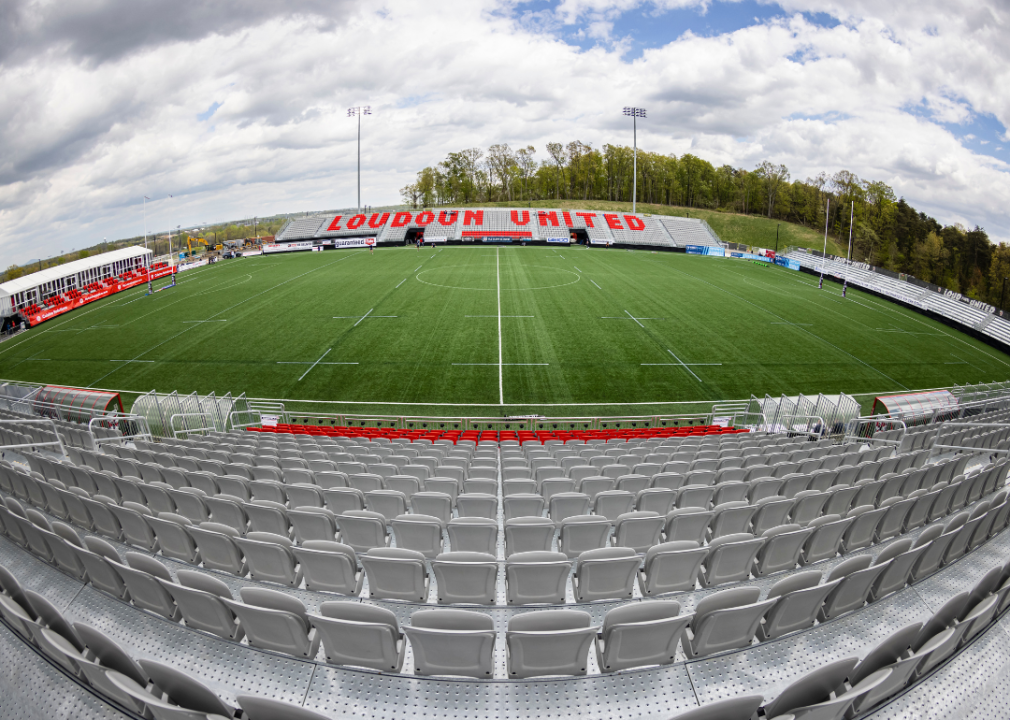
Scott Taetsch // Getty Images
Virginia: Segra Field
– Year opened: 2019
– City: Leesburg
– Capacity: 5,000
– Team: Washington Spirit (NWSL)
With a split-home stadium slate between Segra Field and Audi Field, the Washington Spirit are scheduled to host five games during 2022 at their Leesburg home. That’s enough to qualify for this list, making Segra Field the only, and thereby oldest, major league stadium in the state of Virginia. The soccer-specific Segra Field is also home to Loudon United of the USL Championship.
Steph Chambers // Getty Images
Washington: Climate Pledge Arena
General view of Climate Pledge Arena in Seattle, Washington
– Year opened: 1962
– City: Seattle
– Capacity: 18,100 (basketball), 17,100 (hockey)
– Teams: Seattle Kraken (NHL), Seattle Storm (WNBA)
The city’s NHL and WNBA teams have done well in their respective leagues and, at home, benefit from $1.15 billion in renovations between 2018 and 2021 to Climate Pledge Arena. The venue was originally built for the 1962 Seattle World’s Fair for a meager $7 million. The 100%-solar-powered building is touted as the world’s most sustainable arena.
Grindstone Media Group // Shutterstock
Wisconsin: Lambeau Field
Exterior of historic Lambeau Field
– Year opened: 1957
– City: Green Bay
– Capacity: 81,441
– Team: Green Bay Packers (NFL)
Lambeau turns 65 in 2022, but like the legendary quarterbacks—Bart Starr, Brett Favre, and Aaron Rodgers—who have thrived on its blizzard-bedeviled field, it seems to get better with age. It’s the oldest continuously operating National Football League stadium and has the third-most capacity among NFL stadiums.
This story originally appeared on Vivid Seats and was produced and
distributed in partnership with Stacker Studio.
